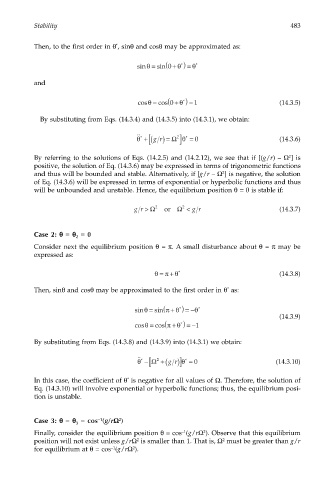Page 502 - Dynamics of Mechanical Systems
P. 502
0593_C14_fm Page 483 Tuesday, May 7, 2002 6:56 AM
Stability 483
*
Then, to the first order in θ , sinθ and cosθ may be approximated as:
sinθ = sin(0 + θ ) = θ *
*
and
cosθ = cos(0 + θ ) = 1 (14.3.5)
*
By substituting from Eqs. (14.3.4) and (14.3.5) into (14.3.1), we obtain:
θ + ( [ gr ) = Ω 2 ] θ = 0 (14.3.6)
*
˙˙*
2
By referring to the solutions of Eqs. (14.2.5) and (14.2.12), we see that if [(g/r) – Ω ] is
positive, the solution of Eq. (14.3.6) may be expressed in terms of trigonometric functions
2
and thus will be bounded and stable. Alternatively, if [g/r – Ω ] is negative, the solution
of Eq. (14.3.6) will be expressed in terms of exponential or hyperbolic functions and thus
will be unbounded and unstable. Hence, the equilibrium position θ = 0 is stable if:
gr > Ω 2 or Ω 2 < gr (14.3.7)
Case 2: θθ θθ = θθ θθ = 0
2
Consider next the equilibrium position θ = π. A small disturbance about θ = π may be
expressed as:
θ =+ * (14.3.8)
π θ
*
Then, sinθ and cosθ may be approximated to the first order in θ as:
(
sinθ = sin π θ ) =− θ *
+
*
(14.3.9)
(
cosθ = cos π θ ) =−1
+
*
By substituting from Eqs. (14.3.8) and (14.3.9) into (14.3.1) we obtain:
[
θ − Ω 2 +(gr θ )] * = 0 (14.3.10)
˙˙*
*
In this case, the coefficient of θ is negative for all values of Ω. Therefore, the solution of
Eq. (14.3.10) will involve exponential or hyperbolic functions; thus, the equilibrium posi-
tion is unstable.
–1
2
Case 3: θθ θθ = θθ θθ = cos (g/rΩΩ ΩΩ )
3
2
–1
Finally, consider the equilibrium position θ = cos (g/rΩ ). Observe that this equilibrium
2
2
position will not exist unless g/rΩ is smaller than 1. That is, Ω must be greater than g/r
–1
2
for equilibrium at θ = cos (g/rΩ ).

